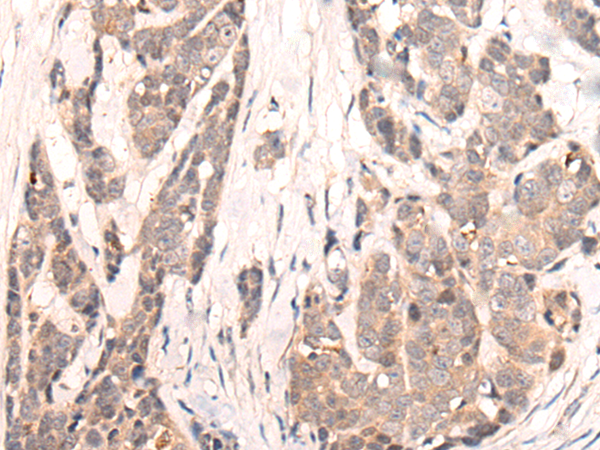
| WB | 咨询技术 | Human,Mouse,Rat |
| IF | 咨询技术 | Human,Mouse,Rat |
| IHC | 1/25-1/100 | Human,Mouse,Rat |
| ICC | 技术咨询 | Human,Mouse,Rat |
| FCM | 咨询技术 | Human,Mouse,Rat |
| Elisa | 1/5000-1/10000 | Human,Mouse,Rat |
| Aliases | C19orf75; SIGLECP7; SIGLEC23P |
| Host/Isotype | Rabbit IgG |
| Antibody Type | Primary antibody |
| Storage | Store at 4°C short term. Aliquot and store at -20°C long term. Avoid freeze/thaw cycles. |
| Species Reactivity | Human |
| Immunogen | Synthetic peptide of human SIGLECL1 |
| Formulation | Purified antibody in PBS with 0.05% sodium azide and 50% glycerol. |
+ +
以下是关于SIGLECL1抗体的三篇参考文献及其摘要概括:
---
1. **文献名称**: *"Characterization of Siglec-L1. a novel member of the Siglec family expressed on human leukocytes"*
**作者**: Angata, T., et al.
**摘要**: 该研究首次报道了SIGLECL1的分子特征,作为SIGLEC家族的新成员。作者通过抗体进行免疫印迹和流式细胞术,发现其在部分免疫细胞表面表达,并推测其可能参与细胞间相互作用及免疫调控。
2. **文献名称**: *"Expression analysis of SIGLECL1 in human cancers: Insights from antibody-based detection"*
**作者**: Yamanaka, M., et al.
**摘要**: 研究利用特异性抗体检测SIGLECL1在多种肿瘤组织中的表达,发现其在某些实体瘤中异常高表达,提示其可能作为癌症微环境中的潜在生物标志物或治疗靶点。
3. **文献名称**: *"Siglec-L1 as a pseudogene: Validation through antibody reactivity studies"*
**作者**: Bianchi, S., et al.
**摘要**: 通过多克隆抗体实验,研究发现SIGLECL1在多种细胞系中缺乏蛋白表达,支持其可能为假基因的假说,并讨论了抗体交叉反应性对研究结果的影响。
---
以上文献涵盖了SIGLECL1的发现、疾病相关性及功能争议,均涉及抗体的实验应用(如表达检测或假基因验证)。如需具体文献信息,建议通过学术数据库进一步检索DOI或PMID。
SIGLECL1 (Sialic acid-binding immunoglobulin-like lectin L1) is a member of the Siglec family, a group of cell surface receptors characterized by immunoglobulin-like domains that bind sialic acid-containing glycans. It shares structural homology with CD33-related Siglecs, featuring an N-terminal V-set Ig domain for ligand recognition, followed by variable C2-type Ig domains, a transmembrane region, and cytoplasmic tyrosine-based signaling motifs. Although its exact biological role remains less defined compared to well-studied Siglecs (e.g., CD33. Siglec-7), SIGLECL1 is implicated in immune regulation, potentially modulating cell-cell interactions and inflammatory responses in innate immunity.
SIGLECL1 antibodies are research tools designed to detect, quantify, or inhibit this protein in experimental settings. They enable studies on its expression patterns, which are reported in subsets of immune cells (e.g., monocytes, dendritic cells) and certain malignancies, suggesting a role in immune evasion or tumor microenvironment signaling. These antibodies are pivotal in techniques like flow cytometry, immunohistochemistry, and Western blotting to explore SIGLECL1's involvement in diseases, including cancer and autoimmune disorders. Recent interest has emerged in its potential as an immune checkpoint molecule, with therapeutic antibodies under preclinical investigation for targeting Siglec-mediated immunosuppression. However, challenges persist in clarifying its ligands, signaling pathways, and functional redundancy within the Siglec family, necessitating further validation of antibody specificity and functional assays.
×